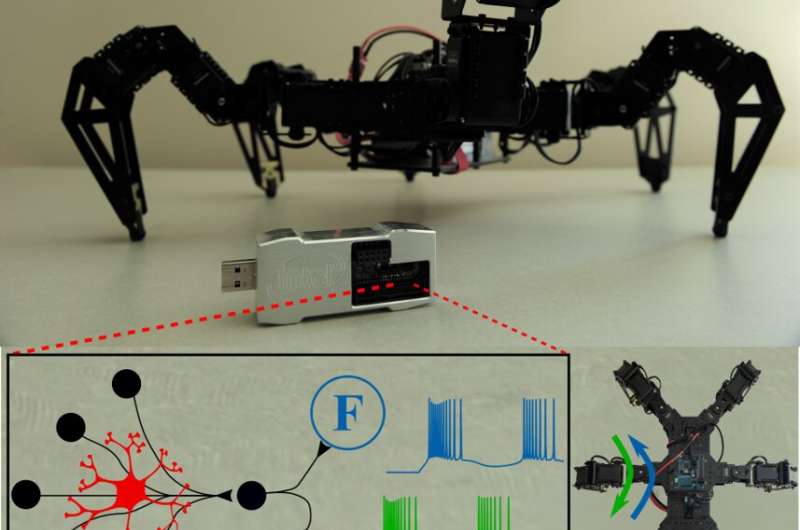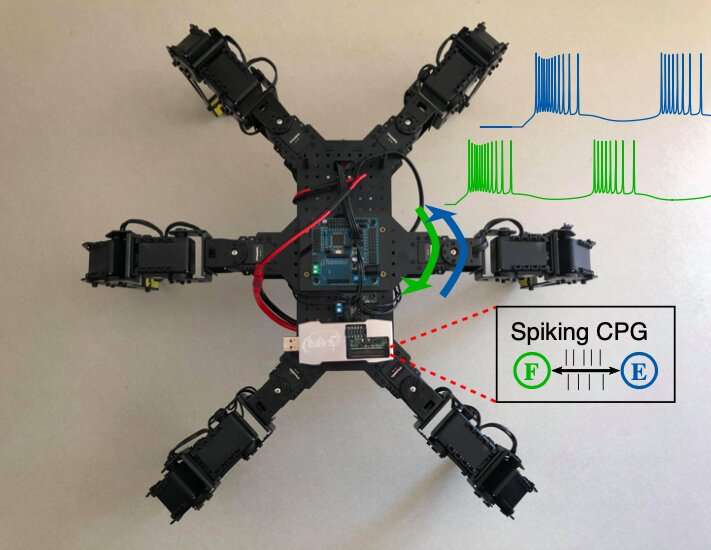July 10, 2020 feature
Using astrocytes to change the behavior of robots controlled by neuromorphic chips

Neurons, specialized cells that transmit nerve impulses, have long been known to be a vital element for the functioning of the human brain. Over the past century, however, neuroscience research has given rise to the false belief that neurons are the only cells that can process and learn information. This misconception or 'neurocomputing dogma' is far from true.
An astrocyte is a different type of brain cell that has recently been found to do a lot more than merely fill up spaces between neurons, as researchers believed for over a century. Studies are finding that these cells also play key roles in brain functions, including learning and central pattern generation (CPG), which is the basis for critical rhythmic behaviors such as breathing and walking.
Although astrocytes are now known to underlie numerous brain functions, most existing computer systems inspired by the human brain only target the structure and function of neurons. Aware of this gap in existing literature, researchers at Rutgers University are developing brain-inspired algorithms that also account for and replicate the functions of astrocytes. In a paper pre-published on arXiv and set to be presented at the ICONS 2020 Conference in July, they introduce a neuromorphic central pattern generator (CPG) modulated by artificial astrocytes that successfully entrained several rhythmic walking behaviors in their in-house robots.
"Everything that artificial neural nets do, and they do a lot these days, is based on the neurocomputing dogma that 'brain equals neurons,'" Konstantinos Michmizos, an assistant professor of computer science at Rutgers University and the lead researcher in this study, told TechXplore. "Astrocytes are two to 10 times more plentiful than neurons. The impact of understanding or mimicking what more of half the brain is doing is enormous."
Michmizos and his team introduced a new approach to neuromorphic research aimed at understanding and mimicking the human brain in its entirety by replicating the seamless ways in which neurons and astrocytes work together to produce specific behaviors. Notably, they are the first to look at artificial intelligence (AI) development from a perspective that does not consider neurons as the only processing unit in the brain, but instead introducing astrocytes in neural networks as a second processing unit.
"Since astrocytes arguably have a key role in brain intelligence, exploring their roles in AI is a fascinating, rewarding direction," Michmizos said. "The main objective behind our recent study was to understand the mysterious language that neurons and astrocytes use to talk to each other as we learn, think and act on our world, by building algorithms inspired by this mysterious dialog in our brain."
First, Michmizos' lab designed computational models that describe what happens inside an astrocyte when it communicates with neurons as they receive and send nerve impulses. They then used these models as building blocks for spiking neuronal-astrocytic networks, which were embedded into neuromorphic chips that can control robots. In their recent study, they used Intel's Loihi neuromorphic chips.
In the system devised by the researchers, robotic functions emerge naturally from the plastic interaction between artificial neurons and astrocytes. Therefore, their CPG's structure and functioning differs greatly from mainstream learning algorithms, which focus only on neurons and do not take full advantage of current knowledge about how the brain works.

"Astrocytes sense the world and change the neuronal activity and the emerging robotic behavior," Michmizos said. "By allowing astrocytes to change how neurons talk to each other, the network changes how it controls the legged robot without changing its topography. This plastic cellular function that changes how neurons transmit nerve impulses in time is a fundamentally different approach from the mainstream learning algorithms that can only change the network's structure."
Typically, neuromorphic chips are used to realize simple neuron models that only reproduce part of the activity of cells in the human brain. Michmizos and his team are among the first to successfully implement neurons capable of more complex behaviors (e.g., bursting behavior) on a neuromorphic chip.
"Our findings demonstrate how astrocytes can control the neuronal component in a spiking network and improve the controller's robustness to noise and adaptability," Michmizos said. "From a brain-morphic point of view, having a low-energy CPG controller is essential for a mobile legged robot deployed in a real-world setting. But there are other ways to explore this work by understanding better how different brain cells can work together as one network."
So far, Michmizos and his team have demonstrated the effectiveness of their CPG by using it to control the walking behavior of a six-legged robot in a simulated environment. Their system achieved remarkable results, allowing the robot to move efficiently at different speeds without being impacted by external sensory disturbances.
"We know a lot about our body, for instance we know what is happening in the heart and in our lungs," Michmizos said. "The brain is the only organ that is hiding its secrets from us. It is an untapped frontier. We now know that brain intelligence, even its diseases emerge from this interaction between neurons and astrocytes. That is why understanding astrocytes will revolutionize how we mimic the brain's intelligence and influence how we treat brain diseases."
The new approach to neuromorphic computing introduced by Michmizos' Lab opens up new possibilities for AI development. The approach has already been incorporated into the curriculum for a computing course at Rutgers University developed by Michmizos, which was one of the first brain computing courses to be offered at a U.S. University.
The CPG presented in their recent paper could soon be applied to robots in real-world environments. Meanwhile, the researchers at Rutgers are working on developing an end-to-end neuro-robotic framework that entails robot navigation and locomotion.
"As we continue to increase our understanding of how astrocytes work in brain networks, we find new ways to harness the computational power of these non-neuronal cells in our neuromorphic models of brain intelligence, and make our in-house robots behave more like humans," Michmizos said. "Our lab is one of the few groups in the world that has a Loihi spiking neuromorphic chip, Intel's research chip that processes data by using neurons, just like our brain, and this has worked as a great facilitator for us. We have fascinating years ahead of us."
More information: Polykretis et al., An astrocyte-modulated neuromorphic central pattern generator for hexapod robot locomotion on Intel's Loihi. arXiv:2006.04765 [cs.NE]. arxiv.org/abs/2006.04765
© 2020 Science X Network















